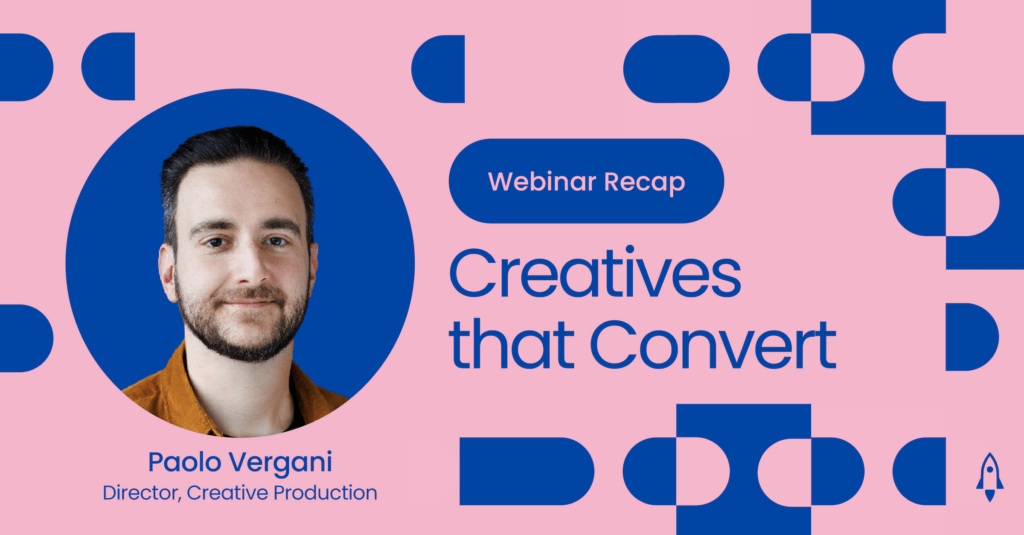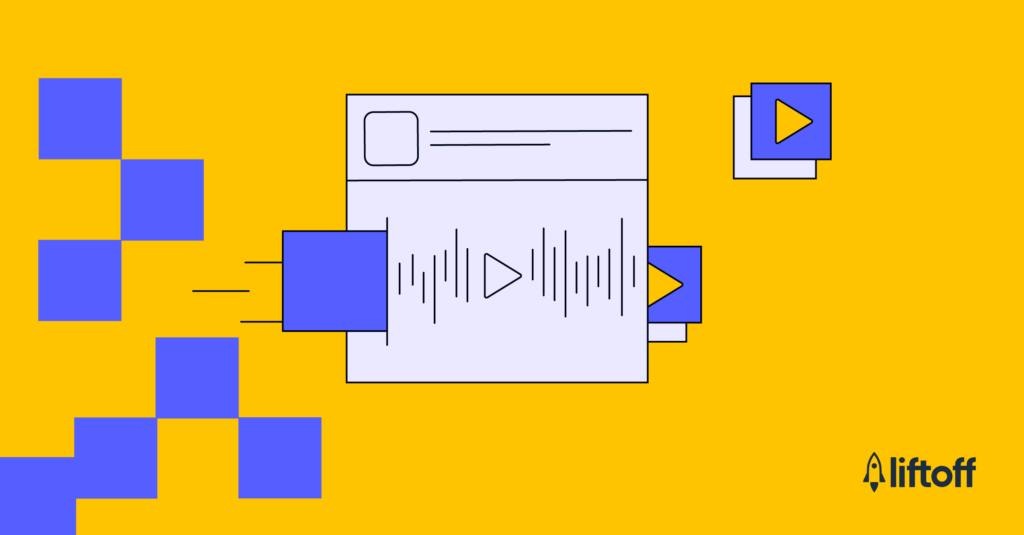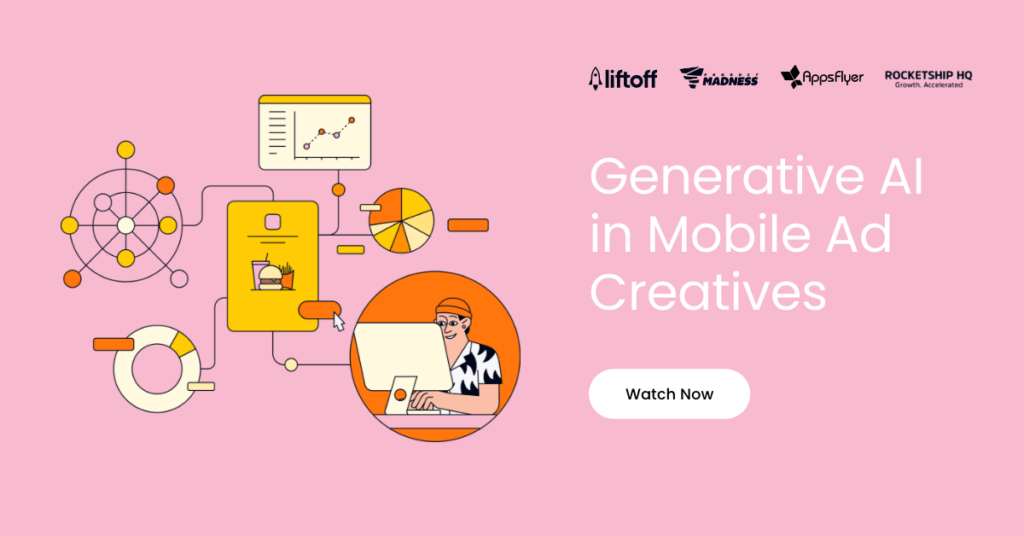
Webinar Recap: Generative AI in Mobile Ad Creatives
Successful mobile advertising has always relied on quality data, and generative AI programs are making it faster and easier for mobile marketers to leverage their data to improve the scale and speed of ad production and campaign optimization.
AI tools from Bard to Midjourney are also changing how marketers design, test, and scale creatives. But how are the industry’s leading experts putting these tools to the test? And what advice can they offer to help those who are only starting to use these tools in their workflows?
To find out, we gathered leading experts from the mobile advertising space for a webinar moderated by Aidan Quest, Senior Director of Generative AI at Liftoff. We asked them to share their advice on the transformative applications of generative AI in mobile ad creatives.
How App Marketers Can Leverage Generative AI Technology
Generative AI tools are a great way to drive campaign performance. In addition to campaign and creative ideation, generative AI tools can be implemented into workflows to quickly test and iterate hundreds of ad creative concepts, helping to determine the creatives that best capture users’ attention.
Betul Ozdemir, UA Manager at leading social casino operator Product Madness, uses generative AI for ideation and testing. She thinks a key benefit of generative AI is testing and modifying existing video and hybrid creatives for programmatic channels. This saves money on having to A/B test multiple formats in the market.
“With AI, we can predict which creative will be the winner with a small amount of money,” Ozdemir says. “After that test, we know which elements of the video are working, and we can iterate from those videos.”
Generative AI tools can also be a valuable asset to the creative production cycle, as Shamanth Rao, CEO of mobile user acquisition firm Rocketship HQ, explains:
“Researching and coming up with new ideas and analyses is something that I think is a less appreciated aspect of generative AI. It could be, ‘Hey, we run these ten scripts. Here’s the metric from the ten scripts. What can you infer from this?’ You would be surprised by what you come up with.”
Liftoff’s Aiden Quest highlights the vast pool of free learning and development resources available and how they can educate relative newcomers on the practical benefits of generative AI tools and how to implement them. A basic level of knowledge is required, especially on the prompting side, because AI output is only as good as the data that’s feeding it.
“I think from an organizational perspective, there are a lot of really great resources out there, from Microsoft, Google, and LinkedIn. Organizations should try and get people more comfortable with this technology, and learning and development is a great place to start. Prompt engineering can be sort of a scary phrase, but all it means is asking good questions, which everyone is able to do.”
If you’re interested in further reading, check out 5 ways to boost creative performance with generative AI.
Using Generative AI to Test Ad Creative: Best Practice
One of the biggest benefits of generative AI in the mobile ad world is to test vast quantities of ad creative at scale. But what components of ad creative can be tested using generative AI? And how can you make sure these tests are efficient enough for the outcomes to deliver the performance you need for your campaigns?
According to Max Barer, Head of Creative Optimization at mobile marketing SaaS platform AppsFlyer, the scale of mobile ad creative testing is ramping up.
“Just think about how easy it is to produce hundreds of variations of the same creative while playing with text, buttons, colors, and backgrounds,” Barer says. “That’s so easy. And it creates a new bottleneck because the testing budgets eventually are limited.”
One of the easiest ways to avoid a potential bottleneck is by pre-testing the testing phases of your ad creative. This might sound complicated, but it doesn’t have to be. It just requires clearly defined objectives and A/B testing across your various ad creatives to ensure only the best aspects of your creative are making it through.
Or, as Betul Ozdemir explains:
“Gen AI creatives are not very different than the other creative testing processes. But, when testing and iterating AI-denoted ad creatives, it’s essential to set a clear objective and define what you want to achieve with the ads. This might be higher CTR, higher increased conversion ratios, or higher loss.
“Also, it’s super essential to look at the scalability of the creative you’re producing,” Ozdemir continues. “So if the creative is not scaling in a BAU environment, it means that even though it is a winner, it is not a good ad.”
Rockship HQ’s Shamanth Rao believes it’s important to look beyond strict A/B testing and tap into other testing, such as hook tests, rather than just contact tests.
“Basically, we test 10 different hooks (the first three seconds) and see which one’s resonating—because 60 percent of people never get past your first three seconds,” Rao says. “So if you’re testing the entire concept, you’re not reaching most people. I’d rather we test the visual hooks first. I wouldn’t do a strict A/B test, because that would cost a lot. Let the algorithms dictate which creative is scalable.”
Ensuring Generative AI Ad Creative Stays On-Brand
Of course, when you’re using generative AI tools at scale, you need to make sure that any ad creative you’re producing adheres to brand guidelines and doesn’t infringe on IP. So, how can you make sure that’s the case?
Shamanth Rao uses a method he dubs ‘modularization,’ where certain aspects of ad creative, such as narrative elements, storylines, and visual cues, are treated as their own building blocks with separate approvals.
“We can iterate on those building blocks and get a lot of different creative spend easily,” Rao says.
AppFlyer’s Max Barer says that AI can actually be a good way of ensuring AI ad creative stays within guidelines if systems are being fed the right data. However, this would require implementing a custom GPT as part of an AI gateway, which ensures compliance with the GPT’s usage limits. Your custom GP can also be used to enforce other brand guidelines, such as tone of voice, in creative copy.
“You can teach AI your own data, like brand and style guidelines and other elements affecting creative. This can be a gateway or not a gateway because you still want to rely on that. You have a brand and an IP to protect.”
This makes it easier to filter out outliers or ad creative that isn’t considered ‘brand safe’.
How App Marketers Can Find Success with Generative AI
There’s great potential in the growing popularity of generative AI tools within app marketing, so many clients of ad networks and performance marketing agencies will likely be using these tools themselves.
With that in mind, how can app marketers deliver the best value to their clients and differentiate themselves?
The answer, according to Liftoff’s Aiden Quest, is reliable data. After all, data is the one thing that’s truly bespoke to companies. A lot depends on how companies collect and use their data, and generative AI tools and machine learning products are only as good as their data inputs. Gathering this data now and thinking about how it can be used in the future is one of the easiest ways for performance marketers to stay ahead in a fiercely competitive marketplace such as app marketing.
“Do the work now to get your data ready for these future models that can leverage a higher amount of data or a wider amount of signal with multimodal models and things like video,” Quest says. “Think strategically about what data you have that you use daily that helps differentiate you from the market; how can you package that data together in a way that the models will be able to ingest them even now or in the future?”
AppsFlyer’s Max Barer agrees.
“Data is key, and automation is key. You need to prepare your processes to streamline the cycle. It’s an infinite loop. It’s a flywheel of producing creatives, testing, running them in production, collecting data, analyzing, getting insights, and feeding that loop back again. And that’s the way to win. The process should be automated.”
If you’d like to learn more about using generative AI for mobile ad creative, watch the full webinar on demand.




